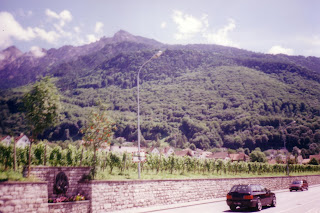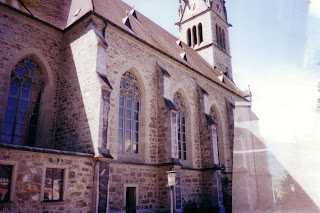 Driving to Switzerland
Driving to Switzerland
I called home and found out today that my dog had had puppies, one of which is my current dog. :)
Most of today was spent on the bus, and for at least part of it I slept. We stopped for lunch at nearly one, and I got to exercise my French again, helping people order from a fast food place. It was kind of weird, because in class we learned much more about ordering from cafés than from fast food joints. I got fries and a Coke, because 1) I am selectively cheap and 2) I love fries and Coca-Cola.
Now would be a good time to tell you a little more about our bus group. When we first arrived at Gatwick, my friends and I just plopped down near the front. But somehow we eventually moved toward the back, joining a few other people from our school and seven kids from three or four different schools. We made friends with them and ended up having good times. The Back of the Blue Bus Crew is very important to my Europe experience.
A few hours after lunch we were in Switzerland, driving around

Lac Léman. The
lac is known as Lake Geneva in English. Switzerland actually has four official languages: French, German, Italian, and Romansch. The first three are the languages of countries that border Switzerland, and the last is an old language of the area that not many people speak anymore. Switzerland is also broken up into 26 provinces called cantons, and each canton has an official language. We were headed to Valais, whose languages are French and German. From the Lake Geneva area Alex drove us
up to Champéry, where the fear part of our relationship with him really came into play. He took those mountain roads in a coach pulling a trailer at speeds that many people would not attempt in a regular car.
I almost don't want to describe Champéry because it's so amazing. I think most people on the trip would say that it was their favorite place we visited; some of us would say that Champéry is our favorite place in the world.

When we first arrived and got off the bus it was around five or six in the evening, and a church bell was ringing the hour. We looked out across the valley to the mountains with the bells ringing, and it seemed almost surreal. The mountains looked almost as if they were a painted backdrop. One of my friends said that it looked like if you pulled the string the whole vista would roll up into the sky and leave nothing behind. It was like I would imagine living in a snowglobe would be like.
We stayed in the brilliant Hôtel des Alpes. The hotel had a Swiss flag and an American flag hung on the front of the building. Our room was on the first floor, and we had a little balcony that faced the street.


This is the view from our room. The building on the left (well, below, as the formatting makes it) is a church; the one on the right is, I believe, a residence. The flag in the right picture is the flag of the canton of Valais. This is what we looked out our window to see. Furthermore, our room itself was great. Instead of three people per room, as there'd been in London and Paris, we now had two per room. The room had no closet, but a wardrobe; a table and two chairs between the windows; and a pair of beds with featherbeds. It was simple, uncluttered, and wicked comfortable.
After staying in two capital cities, Champéry is a huge change. The town was fairly quiet, and the view was mountains, trees, and streams instead of buildings. The whole ambiance is more peaceful. Champéry is a ski town, so in July there weren't a huge number of tourists. If I ever go back in the winter it might shatter my perception of the town. There was a little festival going on downtown when we arrived, and we walked down to see it before dinner.
We ate dinner at the hotel's dining room, and afterward we walked down to the Centre Sportif (Sporty Center--that's a pretty literal translation) for our orientation meeting. It was down a hill, so we had to walk back up to get to the hotel. But this being Champéry and therefore awesome, there are fountains in town where water flows down from springs through a spigot and into a trough. We were warned to get the water from the spout, not the trough (because the water in the trough has already touched people's hands and sometimes animals' mouths). It was high-quality water. Arrowhead, Poland Spring, Aquafina, Dasani: you got nothin'.
Tomorrow: Chillon, Montreux, and the Best Concert Ever
 My life flows on in endless song
My life flows on in endless song 


















































